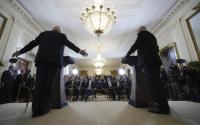Department of Homeland Security Issues Grossly Lax Dirty Bomb Cleanup Guidance: "A Nuclear Katrina in the Making"
4 January 2006
The Department of Homeland Security (DHS) today issued new guidelines for responding to a radiological "dirty" bomb that would permit doses to the public equivalent to tens of thousands of chest X-rays without requiring intervention and cleanup. The federal government estimates radiation doses that large would produce cancer or leukemia in a quarter of those exposed. (This is on top of the number of cancers that would occur in the absence of the extra radiation exposure.)
Watchdog groups accused DHS -- already under attack for its ineffective response to Hurricane Katrina -- of continuing its inadequate response to disasters. "Katrina revealed DHS doing nothing while thousands of people were left stranded and at risk," said Daniel Hirsch, President of the Los Angeles-based Committee to Bridge the Gap, which monitors governmental radiation policy. "Now DHS is proposing a nuclear Katrina -- a formal policy of allowing the public to be exposed to massive radiation doses from a dirty bomb while the government does nothing to protect them."
The DHS guidance was published today in the Federal Register. Although public comment will be permitted, the guidance is immediately effective. Leaked versions of the draft guidance previously provoked a storm of controversy, with approximately a hundred organizations attacking it as dangerously lax, but the final version is essentially unchanged.
The guidance permits radioactive contamination from a terrorist dirty bomb to remain in place, with no long-term cleanup measures required, at doses up to 10,000 millirems per year indefinitely. This is about a thousand times higher dose and risk than EPA Superfund guidance currently allows for cleanup of the nation's most contaminated sites.
"Some pro-nuclear government officials publicly claim that a radiological weapon couldn't cause any harm except fear," said Diane D'Arrigo of the Nuclear Information and Resource Service, a Washington, D.C. policy group. "Yet in DHS FEMA guidance, the government is quietly admitting that radiation from dirty bombs could cause one in four people to get cancer—and makes it potentially acceptable to leave that contamination long into the future while people live and work in the area." DHS's dirty bomb "cleanup" levels far exceed all previous US health guidance, regulations and risk levels.
Proponents of the relaxed dirty bomb cleanup standards have misleadingly tried to compare the permitted doses to natural background. However, the guidance would in fact allow doses thirty times higher than background. Furthermore, background radiation isn't harmless. Official government radiation risk estimates indicate that about one of every thirty people in this country—or approximately 10 million of the nearly 300 million American population -- will develop cancer from exposure to background radiation. "Permitting huge additional doses to be added to what people already get from background is unacceptable from a public health standpoint," said Hirsch.
Copies of an analysis of the guidance are available upon request. See http://www.nirs.org/radiation/radstds/radstdshome.htm for the public interest group letters and calculations.






